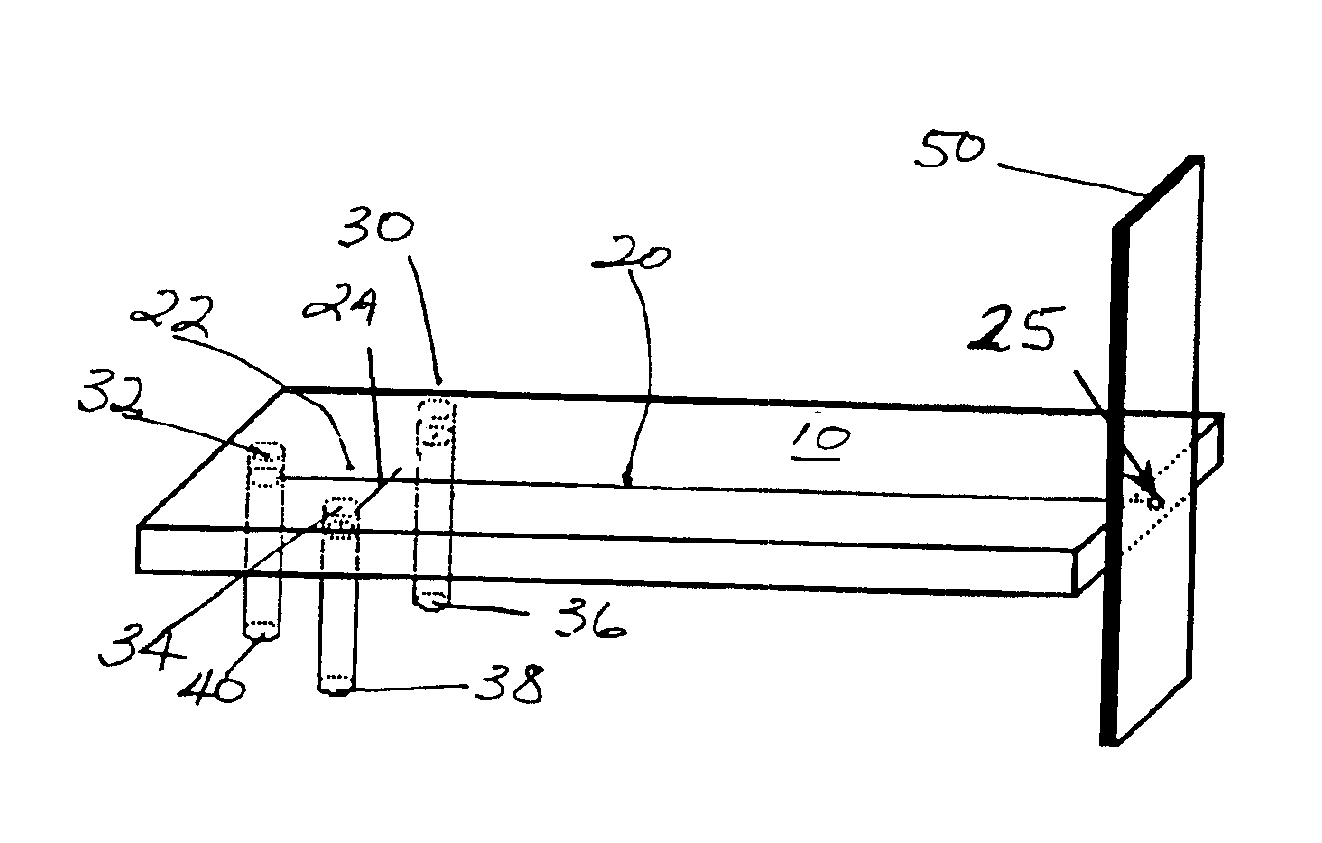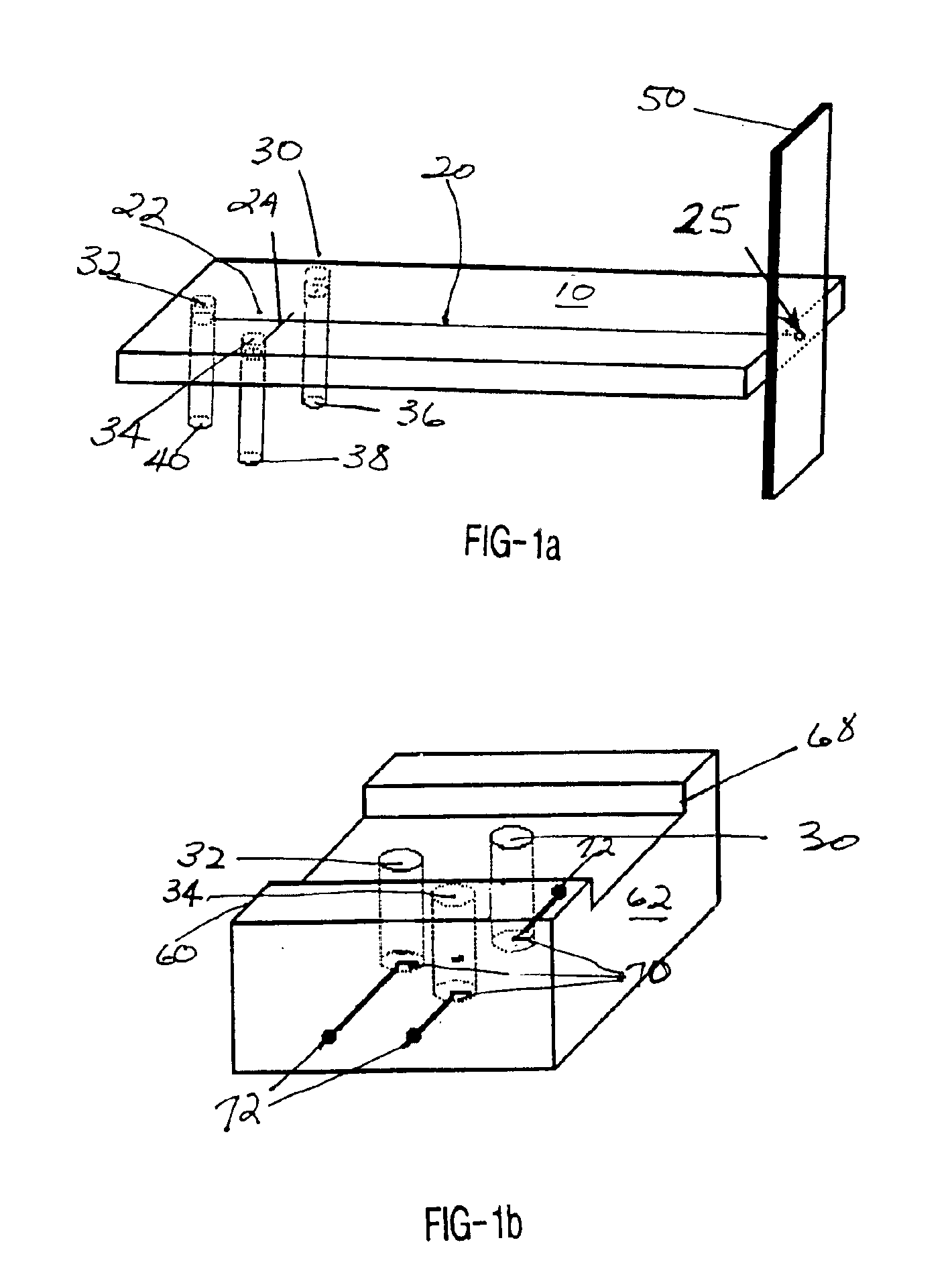Microfluidic devices with thick-film electrochemical detection
- Summary
- Abstract
- Description
- Claims
- Application Information
AI Technical Summary
Benefits of technology
Problems solved by technology
Method used
Image
Examples
example 1
Apparatus Construction
A high-voltage power supply with an adjustable voltage range between 0 and +4000 V was employed. Glass microchannel separation chips were fabricated at Alberta Microelectronic Corp. (AMC Model MC-BF4-001, Edmonton, Canada), using standard microphotolithographic technology, including wet chemical etching and thermal bonding techniques, as depicted in FIG. 1a. The resulting glass chip 10 consisted of a glass plate (120×87 mm), with a 77 mm long separation channel 20 located between a deliberately blocked and unused reservoir 32 and the channel outlet 24 at the detection reservoir 88, and a 10 mm long injection channel 24, located between the sample reservoir and the buffer reservoir. The two channels crossed each other halfway between the sample and the buffer reservoir and 5 mm from the blocked reservoir yielding a separation channel with an effective length of 72 mm. Each channel had a half-circle cross section, with a maximum depth of 20 μm and a width of 50 μ...
example 2
Screen-Printed Electrodes
Screen-printed electrodes were printed with a semi-automatic printer (Model TF 100, MPM, Franklin, Mass.). One of three different carbon inks were utilized for fabricating the working electrode, Acheson ink Electrodag 440B (49AB90) (Acheson Colloids, Ontario, CA), Ercon Ink G-448(I) (Ercon, Waltham, Mass.) and a ESL ink RS12113 modified to contain 30% extra carbon (Electro-Science Laboratories Inc., PA). Printing was performed through patterned stencils (100 μm thick, Specialty Photo-Etch, Inc., Texas) onto 100×100×0.64 mm alumina ceramic plates. Each plate consisted of 30 strips (33.3×10.0×0.64 mm) with each strip being defined by a laser pre / semi cut. The total printing procedure consisted of the following steps. A carbon ink working-electrode layer (0.3×8.0 mm) was first printed on each of the strips of the ceramic plate and was cured at 100° C. for 30 minutes. Then, a silver Ink (Ercon R-421 (DRE-68)) contact layer (1.5×21.0 mm), partially overlapping th...
example 3
Electrophoresis Procedure for Catecholamines and Nitroaromatic Explosives
Prior to use, the channels of the CE chip of Example 1 were treated by rinsing with a 1.0 M sodium hydroxide solution for 20 minutes, followed by deionized water for 1 minute, 1.0% hydrochloric acid for 20 minutes, and finally with deionized water for 1 minute. For the separation, the buffer and sample reservoirs in the chip holder and the corresponding pipette tips on the micro-channel chip were filled with 250 μl buffer and sample solutions, respectively. The chip was then placed in its holder with the pipette tips pointing downwards into the reservoirs and the detection reservoir was filled with buffer solution. Finally, the high voltage power supply was connected to the reservoirs. In order to fill the injection channel between the separation channel and the sample reservoir with sample solution, +1500 V was applied for 30 seconds to the sample reservoir with the detection reservoir grounded and the buffer ...
PUM
| Property | Measurement | Unit |
|---|---|---|
| Thickness | aaaaa | aaaaa |
| Thickness | aaaaa | aaaaa |
| Thickness | aaaaa | aaaaa |
Abstract
Description
Claims
Application Information
 Login to View More
Login to View More - R&D
- Intellectual Property
- Life Sciences
- Materials
- Tech Scout
- Unparalleled Data Quality
- Higher Quality Content
- 60% Fewer Hallucinations
Browse by: Latest US Patents, China's latest patents, Technical Efficacy Thesaurus, Application Domain, Technology Topic, Popular Technical Reports.
© 2025 PatSnap. All rights reserved.Legal|Privacy policy|Modern Slavery Act Transparency Statement|Sitemap|About US| Contact US: help@patsnap.com



